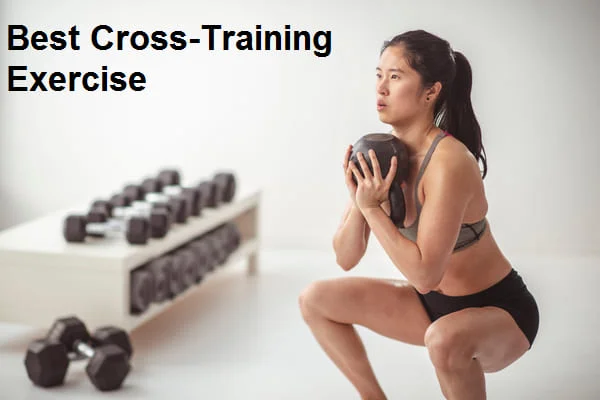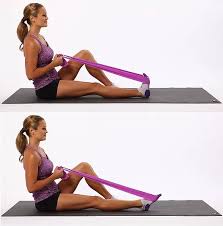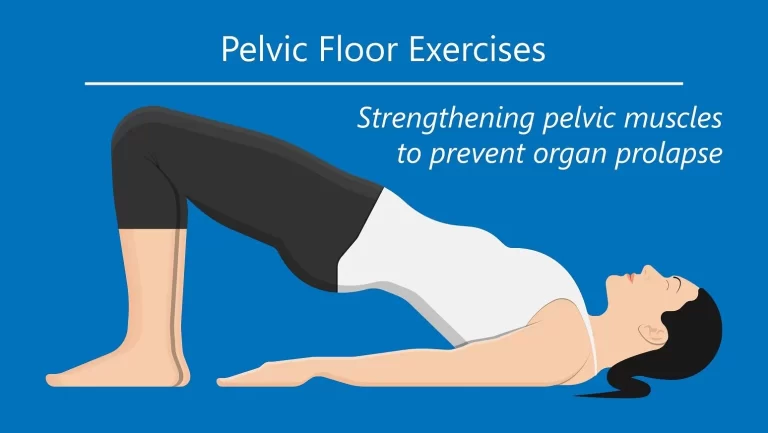Best Cross-Training Exercise For Athletes
Introduction
Cross-training exercises are the usage of many activities to promote overall conditioning. Cross-training is an exercise plan that involves employing different forms of training than the athlete’s primary sport. The goal is to create particular fitness components.
Cross-training exercises are a method of varying your fitness program by mixing different sorts of workout activities. It is critical to include a range of workouts when working out. workouts that lack variation raise your risk of injury due to repeated strain or overuse. Cross-training should include aerobic activity, strength training, and flexibility activities such as yoga or Pilates.
Cross-training Exercise provides various advantages, including full-body conditioning, improved skill, agility, and balance, greater flexibility in workout plans, and the ability to work when injured. The most essential advantage of cross-training is that it minimizes the chance of injury by exercising specific muscle groups while others rest.
Athletes sometimes devote all of their efforts to training and succeeding in a single sport. However, some athletes choose to practice with a range of various activities to improve their performance in their primary sport.
This method, which is often known as cross-training, has various potential benefits for sports performance and general health. This article describes cross-training, including what it is, its advantages, the ideal activities for runners, and a few exercise examples.
What is Cross-Training?
Cross-training is described as an exercise plan that employs numerous types of training unrelated to the athlete’s primary activity to build a specific fitness component.
Cross-training involves activities not typically linked with a sport’s routines and workouts. The exercises give some relief from the regular stress of training in a certain activity, allowing the muscles, tendons, bones, joints, and ligaments a rest.
Cross-training, which was first popularised by runners, is now practiced by cyclists, swimmers, triathletes, and a variety of other athletes. Most athletes prioritize cross-training during their off-season when sport-specific training volume is reduced.
These workouts balance an athlete by targeting the muscles from a different angle or resistance. Cross-training is a great way to take a break from your typical sport-specific activities while staying in shape.
Another common reason for doing cross-training is seasonal weather changes. When the weather isn’t cooperating for outdoor activities, some sportsmen can choose indoor alternatives.
Any exercise or activity that is not related to a specific sport can be utilized for cross-training. Weight training is a popular cross-training strategy. Cross-training activities include swimming, cycling, jogging, and even skating. As cross-training strategies, circuit training and gymnastics are regaining popularity.
Example of The Cross-Training for Athletes
Here are Some typical examples of cross-training contain:
- Cycling is a substitute workout that runners use to develop and maintain their endurance.
- Rowing exercises help swimmers maintain their fitness level and target comparable muscle regions.
- Football players use weightlifting to gain strength and bulk or running to increase their endurance.
- Basketball players doing a high-intensity spinning class to increase their leaping power.
- Volleyball players are using yoga to aid in their recuperation after training.
Advantages of The Cross-Training for Athletes
Cross-training is a widespread approach to exercise. There are several advantages, regardless of whether you’re a competitive athlete or just want to stay healthier overall:
- Enhances general fitness: Cross-training aids in the development of several fitness facets, such as muscular strength, flexibility, balance, and agility, as well as cardiovascular endurance. This results in improved general health and a more comprehensive basis of fitness.
- Decreases the chance of injury: Cross-training can help prevent overuse injuries by reducing repetitive stress on the same muscles and joints. You normally won’t have to stop your entire fitness program or your training schedule if you do get hurt. You might be able to change or replace your activities according to what your doctor recommends.
- Prevents distraction: Adding variety to your exercise routine preserves it interesting and fresh, increasing the likelihood that you’ll stay with it for an extended period. That will assist you in staying on the program.
- Enhances performance in your major sport: You may enhance your performance in your primary sport by developing certain skills and physical components through cross-training. Working with different muscle groups might make it easier for your muscles to adjust to new activities.
Types of Cross training Exercises for Athletes
Cardiovascular Workouts
Swimming: A lower-impact training that works the complete body. It is excellent for strengthening endurance and cardiovascular health and is gentle on the joints.
Cycling: An exciting and demanding method to raise your heart rate. With a stationary bike, you may ride both indoors and outside.
Running: A traditional cardiovascular workout that increases cardiovascular health and helps you burn calories.
Elliptical training: An activity that simulates running action without putting as much strain on your joints.
Dancing: Dancing is a friendly and pleasant form of exercise. You can enhance your cardiovascular health, flexibility, and coordination by dancing.
Hiking: Hiking is a fantastic way to enjoy the outdoors and gain fitness. Hiking can help you lower stress, increase muscle endurance, and enhance your cardiovascular health.
Strength Workout for Athletes
Weightlifting: Adding weight to your body helps you gain strength and muscular mass. Additionally, it can lower your chance of injury and increase bone density.
Exercises using your body weight as resistance are referred to as bodyweight exercises. They are an excellent, non-equipment method of developing strength and muscle. Exercises like lunges, dips, squats, and push-ups are examples.
Strength training involving several back-to-back exercises with little respite is called circuit training. It’s a fantastic method to work out your entire body quickly.
Flexibility Workout for Athletes
Yoga: This kind of exercise involves meditation, breathing techniques, and physical postures. Your flexibility, strength, balance, and mental health may all be enhanced with yoga.
Pilates: Pilates aims to increase flexibility and strengthen the core, much like yoga does. It is an excellent method for lowering back discomfort and enhancing posture.
Stretching: Stretching helps you become more flexible and lowers your chance of getting hurt. Stretches come in a variety of forms, and they cater to all the main muscle groups.
Rock Climbing for Athletes
Climbing rocks is a demanding and satisfying sport that may enhance your coordination, strength, and flexibility.
Martial arts for Athletes
Martial arts is an excellent full-body workout and self-defense course. Additionally, martial arts may help you become more focused and disciplined.
CrossFit for Athletes
CrossFit is a high-intensity exercise regimen that incorporates aspects of gymnastics, weightlifting, and metabolic conditioning
How to begin cross-training for Athletes?
Consult your doctor to ensure it is safe for you to start any new workout plan before you do. Individuals with specific physical limitations should not participate in particular activities.
Every successful workout plan contains these three elements:
- Cardiovascular activity: Walking, stair climbing, and skating are aerobic exercises that strengthen the heart.
- Strengthening exercise: Muscle tone and strength can be developed using strength training exercises like push-ups, circuit training, and weightlifting.
- Stretching Exercise: Stretches, yoga, Pilates, and other flexibility exercises assist in maintaining flexible, nimble muscles.
To gain the most advantage from exercise, you should do at least 30 minutes of medium activity on most days. You can break the 30 minutes of activity into shorter periods if it adds up over the day. When creating a cross-training program, evaluate what kind of activities are easily available to you.
Determinate that physical training is not limited to sports like jogging or weightlifting. Dancing, gardening, and housework count, too. Make sure that your list of exercises contains aerobic, strength, and flexibility exercises. Choose exercises that are both convenient and enjoyable.
Here are some more tips to help you begin your cross-training journey:
- Your workouts should begin slowly and be increased in duration and intensity over time.
- Pay attention to your body and take days off when necessary.
- Before initiating any workout practice, warm up and cool down.
- Make sure you cross-train two or three times a week at a minimum.
- An excellent approach to spice up your workout regimen and make it more challenging is to cross-train. Additionally, it helps keep you from being bored and motivated.
The Best Cross-Training Exercises for Athletes
Weight-lifting Cross-Training Exercises for Athletes
These weightlifting exercises can help you in achieving your goal of endurance. Power, core stability, and overall body strength will all grow with these exercises.
Deadlift
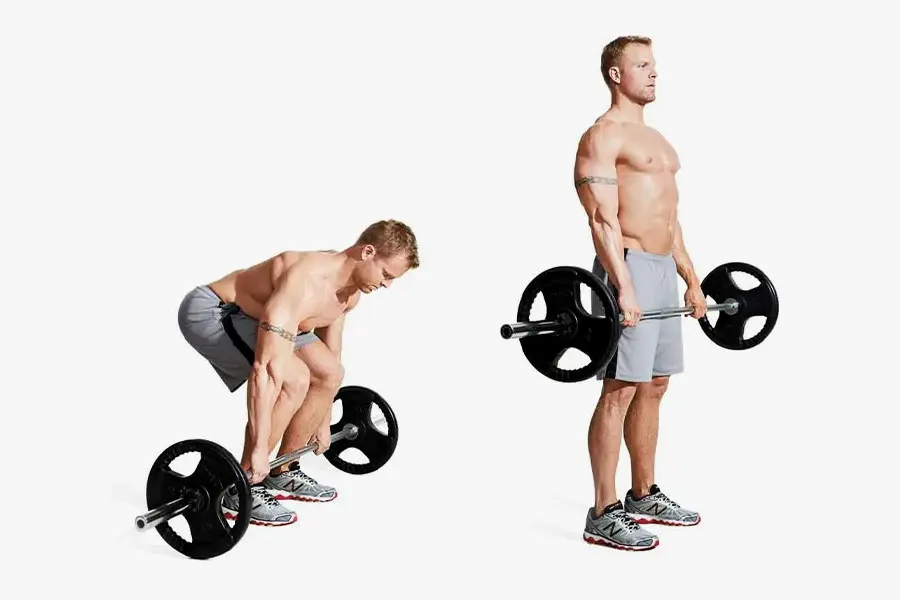
The deadlift is a traditional strength training exercise that targets your posterior chain, or the back of your body, while also working all of your major muscle groups.
The following are the steps of doing a deadlift:
- Stand shoulder-width apart with the dumbbell or barebell in front of you.
- Bend down and take an overhand or underhand hold on the barbell.
- Preserve a straight back and an engaged core.
- Raise the barbell off the base by driving your hips forward.
- Hold the barbell at your hips and stand up straight.
- Lower the barbell to the ground with caution.
Squat
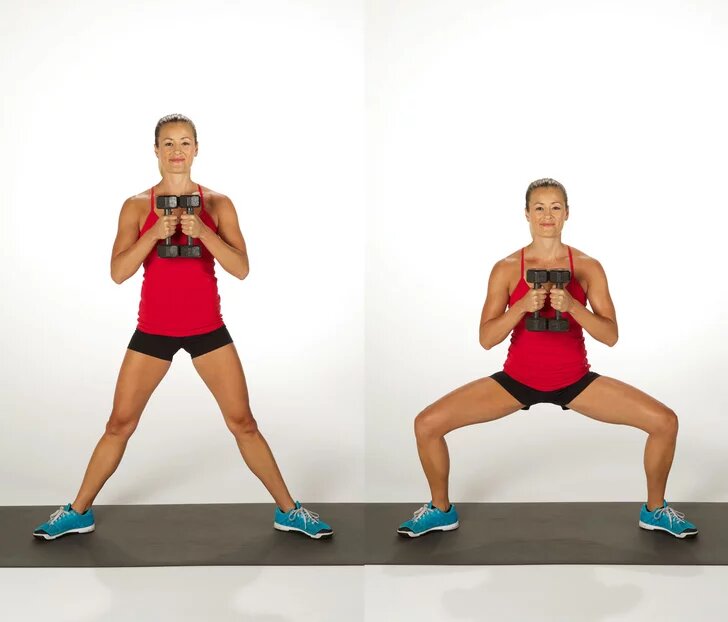
Any type of squat, including the back, front, goblet, overhead, and dumbbell variations, tones the whole lower body, the core, and a large portion of the posterior chain.
- Stand with your feet shoulder-width apart or slightly wider, and your toes pointing outward.
- Preserve a straight back and engage your core.
- As if you were sitting in a chair, push your hips back and bend your knees.
- Lower your body till your thighs are parallel to the ground, or slightly lower if you have the flexibility.
- Maintain an equal weight distribution on your heels and avoid allowing your knees to collapse inward.
- To return to the initial stance, push through your heels and engage your glutes.
The Overhead Press

Although the overhead press appears straightforward, it is a highly technical exercise that works the upper body predominantly and calls for extensive lower-body bracing and core stability.
- Stand shoulder-width apart with your feet shoulder-width apart and the barbell or dumbbells at your shoulders, palms forward.
- Preserve a straight back and engage your core.
- Extend your arms fully overhead while pressing the weight squarely overhead. Controllably drop the weight back to your shoulders.
Single-Leg Deadlift
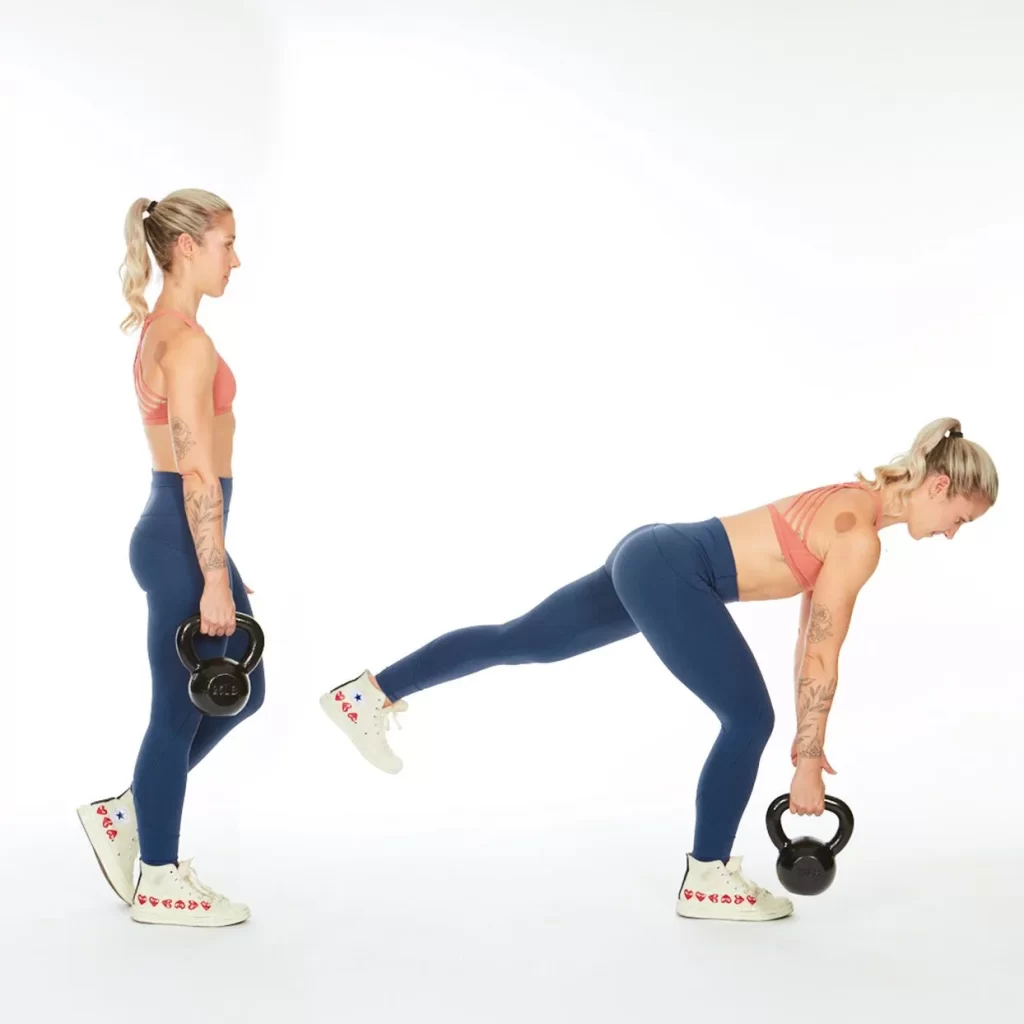
Exercises that require unilateral movement, such as the single-leg deadlift with dumbbells or kettlebells, have to use your core and put in a lot of effort to keep your spine in a neutral position. This ability translates into improved core control and posture during endurance training.
- Set your feet hip-width apart and stand erect.
- Preserve a straight back and engage the core.
- Extend one of your legs behind you, toes pointing and leg straight.
- Lower your hips as if you were sitting, maintaining your rear leg straight and your body straight.
- Keep your spine neutral during the exercise.
- Lower yourself till your hamstrings stretch or your rear leg meets the ground.
- To return to the beginning posture, drive through your heel and engage your glutes.
- Rep with the other leg.
A Higher Lunge(Over Head Lunge)
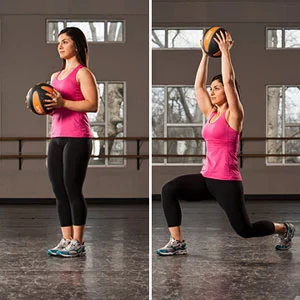
The overhead lunge is a full-body workout that will challenge your muscles and raise your heart rate. If you’re new to the exercise, make sure a coach or trainer walks you through this more advanced technique.
- Standing tall with your feet shoulder-width apart and a weight (barbell, dumbbells, kettlebell) held above with straight arms, perform the following steps.
- Maintain a neutral spine and engage your core throughout the workout.
- Make a big step forward using one leg, dropping your hips until your front knee is bent 90 degrees and your back knee almost touches the ground.
- Maintain an equal distribution of your weight over both feet and avoid allowing your front knee to sink inward.
- To return to the beginning posture, drive through your front heel and engage your glutes.
- Rep with the other leg.
Bodyweight Cross-Training for Athletes
There is no doubt that bodyweight exercises can be just as beneficial in your cross-training journey as weight training, even if weight training is the most efficient approach to gaining muscle and strength.
Jump Up(Air Squat)
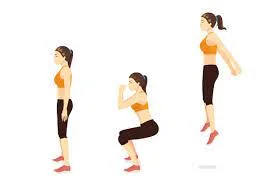
Squats do not require weight to be effective. Air squats are a no-equipment workout you can practice anywhere to help with endurance training.
- Stand tall with your feet shoulder-width apart and your toes pointing outward slightly.
- Preserve a straight back and utilize your core muscles.
- Flex your knees and lower your hips as if you were sitting.
- Maintain proper knee alignment with your toes and avoid allowing your knees to collapse inward.
- Reduce your weight until your thighs are parallel to the ground, or as low as your flexibility will allow.
- To return to the initial stance, push through your heels and engage your glutes.
Squat in a Pistol Pose(And Variations)
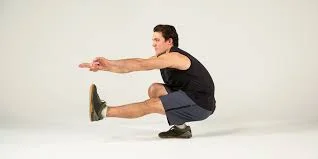
One-leg squats allow you to burn fat in your leg without using any weight. Without the use of a machine, pistol squats are “genuine” single-leg squats. If you lack the necessary strength, mobility, and balance, you can still perform a variety of pistol squat variations via alternate exercises. Examples include split squats, Bulgarian split squats, and pistols that are compatible with TRX.
- To maintain balance, stand tall with your feet hip-width apart and your arms stretched out in front of you.
- Preserve a straight back and engage your core.
- Transfer your weight on one leg and stretch the other leg out in front of you with your toes pointing.
- Bend your supporting knee and drop your hips as if you were sitting.
- preserve a straight extended leg with your rear heel off the base.
- Reduce your body weight until your thigh is parallel to the ground, or as low as your flexibility will allow.
- To return to the beginning posture, push through your heel and engage your glutes.
- Rep with the other leg.
Plank
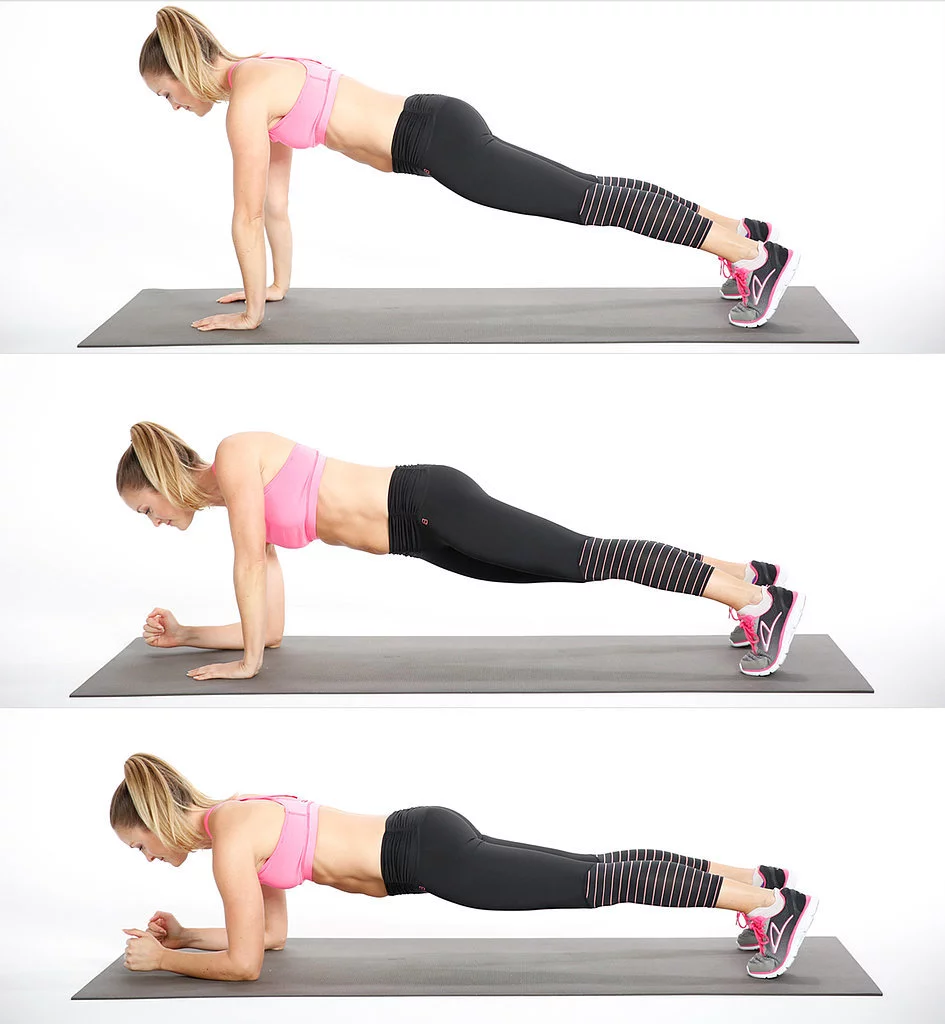
Planks, which are certainly the best exercises for strengthening your core, teach you to brace your core to protect your spine and increase the strength of your core muscles.
- Begin in a press-up posture, forearms on the ground, elbows bent at a 90-degree angle. The shoulders should be precisely over the elbows.
- Maintain a straight line from head to heels. Draw your belly button in towards your spine by using your core muscles.
- Hold this posture for 30-60 seconds, or as long as your form allows.
Push-Ups

Push-ups are not only useful for developing upper-body strength, but they also teach you how to employ secondary movers to reach a goal: Pay attention to how your quadriceps and glutes flex during push-ups and plank holds if you haven’t before.
- Begin in a plank posture, with your hands shoulder-width apart and your body straight from head to heels.
- Hold a strong core and a back straight.
- Reduce your body weight until your chest nearly touches the ground.
- To return to the beginning posture, push through your hands and engage your chest and triceps.
Pull-ups
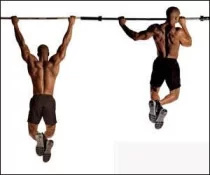
This traditional yet difficult exercise is likely the most effective approach to increasing upper-body pulling strength. Pull-ups are notably beneficial to swimmers, rowers, and snow skiers, but they may also be included in the cross-training programs of other endurance athletes.
- Grab the pull-up bar with an overhand grip, shoulder-width apart, or a little broader grip for an additional challenge.
- Hold on to the bar with your arms fully extended and your torso straight.
- By bending your elbows and pulling your shoulders back, you can engage your core and drive yourself upwards.
- Maintain a chin tuck and prevent swinging your body.
- Drag yourself up until your chin gets to the top of the bar.
- Drop yourself back to the initial stance under control.
Aerobic Cross-Training Workouts for Athletes
- This is where endurance athletes may encounter difficulties. Most personal trainers will not recommend more cardio training to endurance athletes since they already engage in so much aerobic activity. However, your cross-training activities mustn’t replicate your major sport.
- Outside of their activity, endurance athletes can engage in a variety of cardiovascular exercises. For example, Distance swimmers may gain an advantage from elliptical exercise, stair-steppers, and jogging. Rowing or cycling, on the other hand, would be more beneficial to a skier or runner.
How Frequently Is Cross-Training Required for Athletes?
- The frequency of cross-training is determined by several elements particular to your sport and training plan. To ensure optimal performance, trainers typically advise two to three dedicated cross-training sessions per week.
- Adding shorter sessions that concentrate on a particular skill or movement pattern to the start or finish of your regularly scheduled workouts is an additional option. You can also choose to incorporate cross-training activities into your daily warm-up routines.
- Finding a balance that is comfortable for you is crucial. Cross-training should not interfere with your normal training, rather, it should enhance it. Doing too much of anything can lead to overtraining syndrome, so keep in mind that cross-training still counts towards your weekly total effort.
Summary
Including cross-training in your strength and conditioning program can help you achieve several goals, such as increased cardiovascular endurance, training of underused muscle groups, recovery time, overcoming boredom, and a lower chance of injury.
Incorporating cross-training could provide you with the extra push you need to succeed if you feel like you’re having trouble making progress in your sport.
FAQs
Can Injuries Be Prevented by Cross-Training?
You can lower your chance of injury by including cross-training workouts in your training plan. Gaining strength in all of your major muscle groups through weight training or bodyweight exercises will improve alignment, joint support, and body control when performing high-intensity cardiovascular exercises.
Is Cross-Training Necessary For Runners?
Cross-training activities should be a part of a runner’s training plan. Running alone increases the danger of overuse injuries and muscular imbalances. Cross-training also prevents runners from achieving their ideal level of overall fitness.
What Is the Ideal Length of Cross-Training Sessions?
How long a cross-training session should last is not defined. This may vary greatly depending on your training schedule, but for endurance athletes, two or three sessions lasting 30 to 60 minutes per week should be enough.
Why Is It Vital For Endurance Athletes To Cross-Train?
Exercises for cross-training assist endurance athletes in avoiding injuries, especially those caused by overuse. Furthermore, cross-training aids in the development of abilities like power, explosiveness, core strength, and enhanced general strength that endurance athletes might not be able to get through their sport alone.
References
- Cscs, D. P. R. (2021, December 3). Cross-training is effective for all athletes. Healthline. https://www.healthline.com/health/fitness/cross-training
- Cross training – OrthoInfo – AAOS. (n.d.). https://orthoinfo.aaos.org/en/staying-healthy/cross-training/
- Cf-L, A. C. C. C. C. (2023, December 8). 10 cross-training Exercises | Garage Gym Reviews. Garage Gym Reviews. https://www.garagegymreviews.com/cross-training-exercises
- Watson, S. (2014, July 20). Cross training. WebMD. https://www.webmd.com/fitness-exercise/a-z/cross-training

